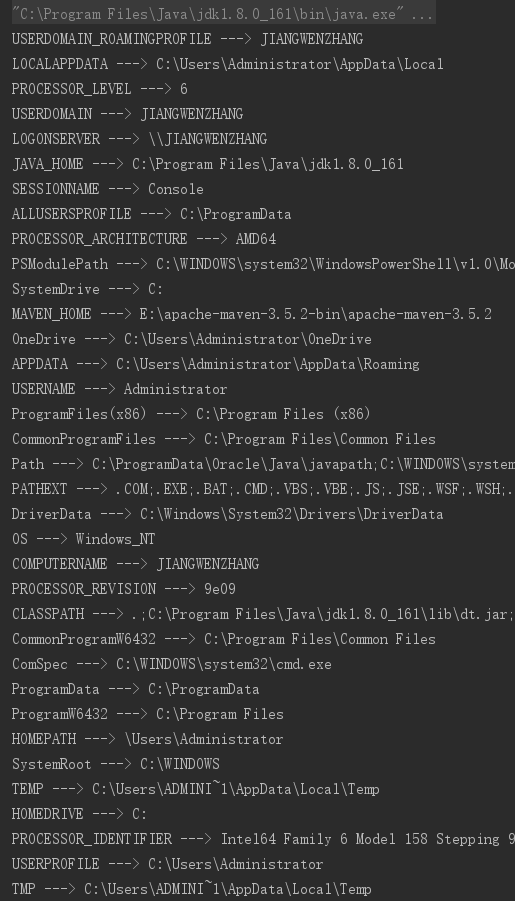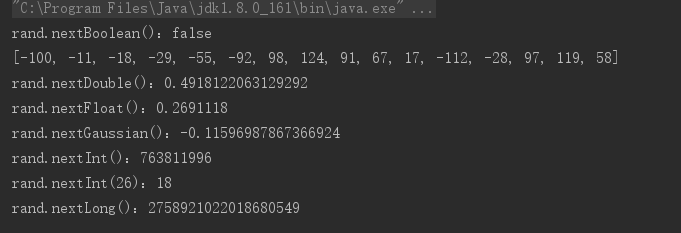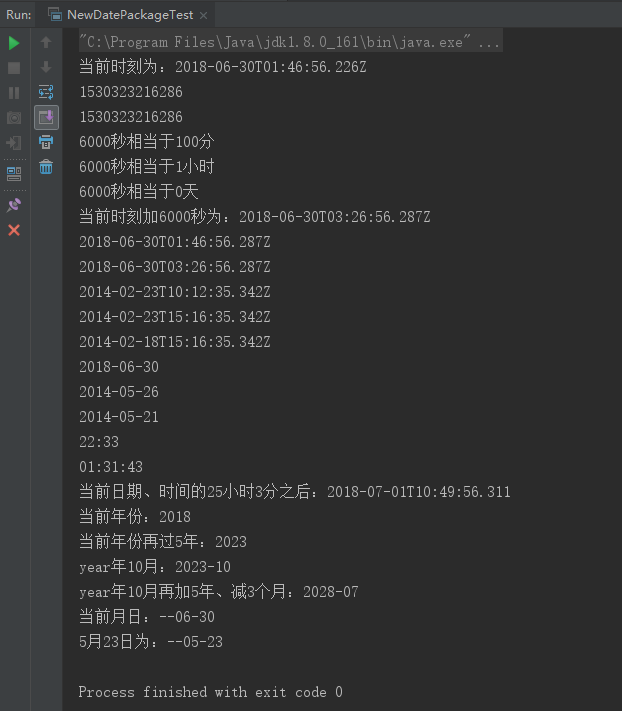Java基础类库
使用Scanner获得键盘输入:
public class ScannerKeyBoardTest { public static void main(String[] args) { // System.in代表标准输入,就是键盘输入 Scanner sc = new Scanner(System.in); // 增加下面一行将只把回车作为分隔符 // sc.useDelimiter("\n"); // 判断是否还有下一个输入项 while(sc.hasNext()) { // 输出输入项 System.out.println("键盘输入的内容是:" + sc.next()); } } }
读取文件内容:
public class ScannerFileTest { public static void main(String[] args) throws Exception { // 将一个File对象作为Scanner的构造器参数,Scanner读取文件内容 Scanner sc = new Scanner(new File("ScannerFileTest.java")); System.out.println("ScannerFileTest.java文件内容如下:"); // 判断是否还有下一行 while(sc.hasNextLine()) { // 输出文件中的下一行 System.out.println(sc.nextLine()); } } }
System类:
通过System类访问操作的环境变量和系统属性:
public class SystemTest { public static void main(String[] args) throws Exception { // 获取系统所有的环境变量 Map<String,String> env = System.getenv(); for (String name : env.keySet()) { System.out.println(name + " ---> " + env.get(name)); } // 获取指定环境变量的值 System.out.println(System.getenv("JAVA_HOME")); // 获取所有的系统属性 Properties props = System.getProperties(); // 将所有系统属性保存到props.txt文件中 props.store(new FileOutputStream("props.txt") , "System Properties"); // 输出特定的系统属性 System.out.println(System.getProperty("os.name")); } }


通过 identityHashCode 判断是否同一个对象:
public class IdentityHashCodeTest { public static void main(String[] args) { // 下面程序中s1和s2是两个不同对象 String s1 = new String("Hello"); String s2 = new String("Hello"); // String重写了hashCode()方法——改为根据字符序列计算hashCode值, // 因为s1和s2的字符序列相同,所以它们的hashCode方法返回值相同 System.out.println(s1.hashCode() + "----" + s2.hashCode()); // s1和s2是不同的字符串对象,所以它们的identityHashCode值不同 System.out.println(System.identityHashCode(s1) + "----" + System.identityHashCode(s2)); String s3 = "Java"; String s4 = "Java"; // s3和s4是相同的字符串对象,所以它们的identityHashCode值相同 System.out.println(System.identityHashCode(s3) + "----" + System.identityHashCode(s4)); } }

Runtime类代表java程序运行时环境:
public class RuntimeTest { public static void main(String[] args) { // 获取Java程序关联的运行时对象 Runtime rt = Runtime.getRuntime(); System.out.println("处理器数量:" + rt.availableProcessors()); System.out.println("空闲内存数:" + rt.freeMemory()); System.out.println("总内存数:" + rt.totalMemory()); System.out.println("可用最大内存数:" + rt.maxMemory()); } }

Runtime类可以直接单独启动一个进程来运行操作系统的命令:
public class ExecTest { public static void main(String[] args) throws Exception { Runtime rt = Runtime.getRuntime(); // 运行记事本程序 rt.exec("notepad.exe"); } }
通过 ProcessHandle (Java 9) 获取进程的相关信息:
import java.util.concurrent.*; public class ProcessHandleTest { public static void main(String[] args) throws Exception { Runtime rt = Runtime.getRuntime(); // 运行记事本程序 Process p = rt.exec("notepad.exe"); ProcessHandle ph = p.toHandle(); System.out.println("进程是否运行: " + ph.isAlive()); System.out.println("进程ID: " + ph.pid()); System.out.println("父进程: " + ph.parent()); // 获取ProcessHandle.Info信息 ProcessHandle.Info info = ph.info(); // 通过ProcessHandle.Info信息获取进程相关信息 System.out.println("进程命令: " + info.command()); System.out.println("进程参数: " + info.arguments()); System.out.println("进程启动时间: " + info.startInstant()); System.out.println("进程累计运行时间: " + info.totalCpuDuration()); // 通过CompletableFuture在进程结束时运行某个任务 CompletableFuture<ProcessHandle> cf = ph.onExit(); cf.thenRunAsync(()->{ System.out.println("程序退出"); }); Thread.sleep(5000); } }
常用类:
Object类:
调用Object实现的clone()方法来得到给对象的副本,并返回该副本。如下实现“自我克隆”:
/** * Description: * 网站: <a href="http://www.crazyit.org">疯狂Java联盟</a><br> * Copyright (C), 2001-2018, Yeeku.H.Lee<br> * This program is protected by copyright laws.<br> * Program Name:<br> * Date:<br> * @author Yeeku.H.Lee [email protected] * @version 1.0 */ class Address { String detail; public Address(String detail) { this.detail = detail; } } // 实现Cloneable接口 class User implements Cloneable { int age; Address address; public User(int age) { this.age = age; address = new Address("广州天河"); } // 通过调用super.clone()来实现clone()方法 public User clone() throws CloneNotSupportedException { return (User)super.clone(); } } public class CloneTest { public static void main(String[] args) throws CloneNotSupportedException { User u1 = new User(29); // clone得到u1对象的副本。 User u2 = u1.clone(); // 判断u1、u2是否相同 System.out.println(u1 == u2); //① // 判断u1、u2的address是否相同 System.out.println(u1.address == u2.address); //② } }

Java7新增的Objects类:
public class ObjectsTest { // 定义一个obj变量,它的默认值是null static ObjectsTest obj; public static void main(String[] args) { // 输出一个null对象的hashCode值,输出0 System.out.println(Objects.hashCode(obj)); // 输出一个null对象的toString,输出null System.out.println(Objects.toString(obj)); // 要求obj不能为null,如果obj为null则引发异常 System.out.println(Objects.requireNonNull(obj , "obj参数不能是null!")); } }

Math类:
public class MathTest { public static void main(String[] args) { /*---------下面是三角运算---------*/ // 将弧度转换角度 System.out.println("Math.toDegrees(1.57):" + Math.toDegrees(1.57)); // 将角度转换为弧度 System.out.println("Math.toRadians(90):" + Math.toRadians(90)); // 计算反余弦,返回的角度范围在 0.0 到 pi 之间。 System.out.println("Math.acos(1.2):" + Math.acos(1.2)); // 计算反正弦;返回的角度范围在 -pi/2 到 pi/2 之间。 System.out.println("Math.asin(0.8):" + Math.asin(0.8)); // 计算反正切;返回的角度范围在 -pi/2 到 pi/2 之间。 System.out.println("Math.atan(2.3):" + Math.atan(2.3)); // 计算三角余弦。 System.out.println("Math.cos(1.57):" + Math.cos(1.57)); // 计算值的双曲余弦。 System.out.println("Math.cosh(1.2 ):" + Math.cosh(1.2 )); // 计算正弦 System.out.println("Math.sin(1.57 ):" + Math.sin(1.57 )); // 计算双曲正弦 System.out.println("Math.sinh(1.2 ):" + Math.sinh(1.2 )); // 计算三角正切 System.out.println("Math.tan(0.8 ):" + Math.tan(0.8 )); // 计算双曲正切 System.out.println("Math.tanh(2.1 ):" + Math.tanh(2.1 )); // 将矩形坐标 (x, y) 转换成极坐标 (r, thet)); System.out.println("Math.atan2(0.1, 0.2):" + Math.atan2(0.1, 0.2)); /*---------下面是取整运算---------*/ // 取整,返回小于目标数的最大整数。 System.out.println("Math.floor(-1.2 ):" + Math.floor(-1.2 )); // 取整,返回大于目标数的最小整数。 System.out.println("Math.ceil(1.2):" + Math.ceil(1.2)); // 四舍五入取整 System.out.println("Math.round(2.3 ):" + Math.round(2.3 )); /*---------下面是乘方、开方、指数运算---------*/ // 计算平方根。 System.out.println("Math.sqrt(2.3 ):" + Math.sqrt(2.3 )); // 计算立方根。 System.out.println("Math.cbrt(9):" + Math.cbrt(9)); // 返回欧拉数 e 的n次幂。 System.out.println("Math.exp(2):" + Math.exp(2)); // 返回 sqrt(x2 +y2) System.out.println("Math.hypot(4 , 4):" + Math.hypot(4 , 4)); // 按照 IEEE 754 标准的规定,对两个参数进行余数运算。 System.out.println("Math.IEEEremainder(5 , 2):" + Math.IEEEremainder(5 , 2)); // 计算乘方 System.out.println("Math.pow(3, 2):" + Math.pow(3, 2)); // 计算自然对数 System.out.println("Math.log(12):" + Math.log(12)); // 计算底数为 10 的对数。 System.out.println("Math.log10(9):" + Math.log10(9)); // 返回参数与 1 之和的自然对数。 System.out.println("Math.log1p(9):" + Math.log1p(9)); /*---------下面是符号相关的运算---------*/ // 计算绝对值。 System.out.println("Math.abs(-4.5):" + Math.abs(-4.5)); // 符号赋值,返回带有第二个浮点数符号的第一个浮点参数。 System.out.println("Math.copySign(1.2, -1.0):" + Math.copySign(1.2, -1.0)); // 符号函数;如果参数为 0,则返回 0;如果参数大于 0, // 则返回 1.0;如果参数小于 0,则返回 -1.0。 System.out.println("Math.signum(2.3):" + Math.signum(2.3)); /*---------下面是大小相关的运算---------*/ // 找出最大值 System.out.println("Math.max(2.3 , 4.5):" + Math.max(2.3 , 4.5)); // 计算最小值 System.out.println("Math.min(1.2 , 3.4):" + Math.min(1.2 , 3.4)); // 返回第一个参数和第二个参数之间与第一个参数相邻的浮点数。 System.out.println("Math.nextAfter(1.2, 1.0):" + Math.nextAfter(1.2, 1.0)); // 返回比目标数略大的浮点数 System.out.println("Math.nextUp(1.2 ):" + Math.nextUp(1.2 )); // 返回一个伪随机数,该值大于等于 0.0 且小于 1.0。 System.out.println("Math.random():" + Math.random()); } }

Java7的ThreadLoaclRandom和Random
ThreadLoaclRandom是Java7新增,是Random的增强版,在并发访问情况下,使用ThreadLoaclRandom代替Random可以减少多线程资源竞争,保证系统具有更好的线程安全性。
Random类用法:
public class RandomTest { public static void main(String[] args) { Random rand = new Random(); System.out.println("rand.nextBoolean():" + rand.nextBoolean()); byte[] buffer = new byte[16]; rand.nextBytes(buffer); System.out.println(Arrays.toString(buffer)); // 生成0.0~1.0之间的伪随机double数 System.out.println("rand.nextDouble():" + rand.nextDouble()); // 生成0.0~1.0之间的伪随机float数 System.out.println("rand.nextFloat():" + rand.nextFloat()); // 生成平均值是 0.0,标准差是 1.0的伪高斯数 System.out.println("rand.nextGaussian():" + rand.nextGaussian()); // 生成一个处于int整数取值范围的伪随机整数 System.out.println("rand.nextInt():" + rand.nextInt()); // 生成0~26之间的伪随机整数 System.out.println("rand.nextInt(26):" + rand.nextInt(26)); // 生成一个处于long整数取值范围的伪随机整数 System.out.println("rand.nextLong():" + rand.nextLong()); } }

Random使用一个48位的种子,如果这个类的两个实例使用同一个种子创建的,对他们以同样的顺序调用方法,则他们会产生相同的数字序列。
public class SeedTest { public static void main(String[] args) { Random r1 = new Random(50); System.out.println("第一个种子为50的Random对象"); System.out.println("r1.nextBoolean():\t" + r1.nextBoolean()); System.out.println("r1.nextInt():\t\t" + r1.nextInt()); System.out.println("r1.nextDouble():\t" + r1.nextDouble()); System.out.println("r1.nextGaussian():\t" + r1.nextGaussian()); System.out.println("---------------------------"); Random r2 = new Random(50); System.out.println("第二个种子为50的Random对象"); System.out.println("r2.nextBoolean():\t" + r2.nextBoolean()); System.out.println("r2.nextInt():\t\t" + r2.nextInt()); System.out.println("r2.nextDouble():\t" + r2.nextDouble()); System.out.println("r2.nextGaussian():\t" + r2.nextGaussian()); System.out.println("---------------------------"); Random r3 = new Random(100); System.out.println("种子为100的Random对象"); System.out.println("r3.nextBoolean():\t" + r3.nextBoolean()); System.out.println("r3.nextInt():\t\t" + r3.nextInt()); System.out.println("r3.nextDouble():\t" + r3.nextDouble()); System.out.println("r3.nextGaussian():\t" + r3.nextGaussian()); } }

为了避免两个Random序列产生相同的数字序列,通常推荐使用当前时间作为Random对象的种子。
BigDecimal类:
使用基本类型的浮点数float、double容易引起数据丢失:
public class DoubleTest { public static void main(String args[]) { System.out.println("0.05 + 0.01 = " + (0.05 + 0.01)); System.out.println("1.0 - 0.42 = " + (1.0 - 0.42)); System.out.println("4.015 * 100 = " + (4.015 * 100)); System.out.println("123.3 / 100 = " + (123.3 / 100)); } }

为此,Java提供了BigDecimal类,该类提供了大量构造器用于创建BigDecimal对象,包括把所有的基本数值类型变量转换成一个BigDecimal对象,也包括利用数字字符串、数字字符数组来创建BigDecimal对象,查看BigDecimal(double val)不推荐使用该构造器,因为使用该构造器有一定的不可预知性。
BigDecimal的基本运算:
public class BigDecimalTest { public static void main(String[] args) { BigDecimal f1 = new BigDecimal("0.05"); BigDecimal f2 = BigDecimal.valueOf(0.01); BigDecimal f3 = new BigDecimal(0.05); System.out.println("使用String作为BigDecimal构造器参数:"); System.out.println("0.05 + 0.01 = " + f1.add(f2)); System.out.println("0.05 - 0.01 = " + f1.subtract(f2)); System.out.println("0.05 * 0.01 = " + f1.multiply(f2)); System.out.println("0.05 / 0.01 = " + f1.divide(f2)); System.out.println("使用double作为BigDecimal构造器参数:"); System.out.println("0.05 + 0.01 = " + f3.add(f2)); System.out.println("0.05 - 0.01 = " + f3.subtract(f2)); System.out.println("0.05 * 0.01 = " + f3.multiply(f2)); System.out.println("0.05 / 0.01 = " + f3.divide(f2)); } }

为了避免程序中对于double运算的繁琐,可以以BigDecimal基础定义一个Arith工具类:
public class Arith { // 默认除法运算精度 private static final int DEF_DIV_SCALE = 10; // 构造器私有,让这个类不能实例化 private Arith() {} // 提供精确的加法运算。 public static double add(double v1,double v2) { BigDecimal b1 = BigDecimal.valueOf(v1); BigDecimal b2 = BigDecimal.valueOf(v2); return b1.add(b2).doubleValue(); } // 提供精确的减法运算。 public static double sub(double v1,double v2) { BigDecimal b1 = BigDecimal.valueOf(v1); BigDecimal b2 = BigDecimal.valueOf(v2); return b1.subtract(b2).doubleValue(); } // 提供精确的乘法运算。 public static double mul(double v1,double v2) { BigDecimal b1 = BigDecimal.valueOf(v1); BigDecimal b2 = BigDecimal.valueOf(v2); return b1.multiply(b2).doubleValue(); } // 提供(相对)精确的除法运算,当发生除不尽的情况时. // 精确到小数点以后10位的数字四舍五入。 public static double div(double v1,double v2) { BigDecimal b1 = BigDecimal.valueOf(v1); BigDecimal b2 = BigDecimal.valueOf(v2); return b1.divide(b2 , DEF_DIV_SCALE , RoundingMode.HALF_UP).doubleValue(); } public static void main(String[] args) { System.out.println("0.05 + 0.01 = " + Arith.add(0.05 , 0.01)); System.out.println("1.0 - 0.42 = " + Arith.sub(1.0 , 0.42)); System.out.println("4.015 * 100 = " + Arith.mul(4.015 , 100)); System.out.println("123.3 / 100 = " + Arith.div(123.3 , 100)); } }

日期时间
Date类
已经过时的Date
public class DateTest { public static void main(String[] args) { Date d1 = new Date(); // 获取当前时间之后100ms的时间 Date d2 = new Date(System.currentTimeMillis() + 100); System.out.println(d2); System.out.println(d1.compareTo(d2)); System.out.println(d1.before(d2)); } }

Calendar类是一个抽象类,他代表日历:
public class CalendarTest { public static void main(String[] args) { Calendar c = Calendar.getInstance(); // 取出年 System.out.println(c.get(YEAR)); // 取出月份 System.out.println(c.get(MONTH)); // 取出日 System.out.println(c.get(DATE)); // 分别设置年、月、日、小时、分钟、秒 c.set(2003 , 10 , 23 , 12, 32, 23); //2003-11-23 12:32:23 System.out.println(c.getTime()); // 将Calendar的年前推1年 c.add(YEAR , -1); //2002-11-23 12:32:23 System.out.println(c.getTime()); // 将Calendar的月前推8个月 c.roll(MONTH , -8); //2002-03-23 12:32:23 System.out.println(c.getTime()); Calendar cal1 = Calendar.getInstance(); cal1.set(2003, 7, 23, 0, 0 , 0); // 2003-8-23 cal1.add(MONTH, 6); //2003-8-23 => 2004-2-23 System.out.println(cal1.getTime()); Calendar cal2 = Calendar.getInstance(); cal2.set(2003, 7, 31, 0, 0 , 0); // 2003-8-31 // 因为进位到后月份改为2月,2月没有31日,自动变成29日 cal2.add(MONTH, 6); // 2003-8-31 => 2004-2-29 System.out.println(cal2.getTime()); Calendar cal3 = Calendar.getInstance(); cal3.set(2003, 7, 23, 0, 0 , 0); //2003-8-23 // MONTH字段“进位”,但YEAR字段并不增加 cal3.roll(MONTH, 6); //2003-8-23 => 2003-2-23 System.out.println(cal3.getTime()); Calendar cal4 = Calendar.getInstance(); cal4.set(2003, 7, 31, 0, 0 , 0); //2003-8-31 // MONTH字段“进位”后变成2,2月没有31日, // YEAR字段不会改变,2003年2月只有28天 cal4.roll(MONTH, 6); //2003-8-31 => 2003-2-28 System.out.println(cal4.getTime()); } }

Java 8专门新增了一个java.time包,该包下包含了如下常用类:
Clock、Duration、LocalDate、LocalTime、LocalDateTime、MonthDay、Year、YearMonth、DayOfWeek、Month。
public class NewDatePackageTest { public static void main(String[] args) { // -----下面是关于Clock的用法----- // 获取当前Clock Clock clock = Clock.systemUTC(); // 通过Clock获取当前时刻 System.out.println("当前时刻为:" + clock.instant()); // 获取clock对应的毫秒数,与System.currentTimeMillis()输出相同 System.out.println(clock.millis()); System.out.println(System.currentTimeMillis()); // -----下面是关于Duration的用法----- Duration d = Duration.ofSeconds(6000); System.out.println("6000秒相当于" + d.toMinutes() + "分"); System.out.println("6000秒相当于" + d.toHours() + "小时"); System.out.println("6000秒相当于" + d.toDays() + "天"); // 在clock基础上增加6000秒,返回新的Clock Clock clock2 = Clock.offset(clock, d); // 可看到clock2与clock1相差1小时40分 System.out.println("当前时刻加6000秒为:" +clock2.instant()); // -----下面是关于Instant的用法----- // 获取当前时间 Instant instant = Instant.now(); System.out.println(instant); // instant添加6000秒(即100分钟),返回新的Instant Instant instant2 = instant.plusSeconds(6000); System.out.println(instant2); // 根据字符串中解析Instant对象 Instant instant3 = Instant.parse("2014-02-23T10:12:35.342Z"); System.out.println(instant3); // 在instant3的基础上添加5小时4分钟 Instant instant4 = instant3.plus(Duration .ofHours(5).plusMinutes(4)); System.out.println(instant4); // 获取instant4的5天以前的时刻 Instant instant5 = instant4.minus(Duration.ofDays(5)); System.out.println(instant5); // -----下面是关于LocalDate的用法----- LocalDate localDate = LocalDate.now(); System.out.println(localDate); // 获得2014年的第146天 localDate = LocalDate.ofYearDay(2014, 146); System.out.println(localDate); // 2014-05-26 // 设置为2014年5月21日 localDate = LocalDate.of(2014, Month.MAY, 21); System.out.println(localDate); // 2014-05-21 // -----下面是关于LocalTime的用法----- // 获取当前时间 LocalTime localTime = LocalTime.now(); // 设置为22点33分 localTime = LocalTime.of(22, 33); System.out.println(localTime); // 22:33 // 返回一天中的第5503秒 localTime = LocalTime.ofSecondOfDay(5503); System.out.println(localTime); // 01:31:43 // -----下面是关于localDateTime的用法----- // 获取当前日期、时间 LocalDateTime localDateTime = LocalDateTime.now(); // 当前日期、时间加上25小时3分钟 LocalDateTime future = localDateTime.plusHours(25).plusMinutes(3); System.out.println("当前日期、时间的25小时3分之后:" + future); // 下面是关于Year、YearMonth、MonthDay的用法示例----- Year year = Year.now(); // 获取当前的年份 System.out.println("当前年份:" + year); // 输出当前年份 year = year.plusYears(5); // 当前年份再加5年 System.out.println("当前年份再过5年:" + year); // 根据指定月份获取YearMonth YearMonth ym = year.atMonth(10); System.out.println("year年10月:" + ym); // 输出XXXX-10,XXXX代表当前年份 // 当前年月再加5年,减3个月 ym = ym.plusYears(5).minusMonths(3); System.out.println("year年10月再加5年、减3个月:" + ym); MonthDay md = MonthDay.now(); System.out.println("当前月日:" + md); // 输出--XX-XX,代表几月几日 // 设置为5月23日 MonthDay md2 = md.with(Month.MAY).withDayOfMonth(23); System.out.println("5月23日为:" + md2); // 输出--05-23 } }

变量处理和方法处理
Java9增强的MethidHandle
public class MethodHandleTest { // 定义一个private的类方法 private static void hello() { System.out.println("Hello world!"); } // 定义一个private的实例方法 private String hello(String name) { System.out.println("执行带参数的hello" + name); return name + ",您好"; } public static void main(String[] args) throws Throwable { // 定义一个返回值为void、不带形参的方法类型 MethodType type = MethodType.methodType(void.class); // 使用MethodHandles.Lookup的findStatic获取类方法 MethodHandle mtd = MethodHandles.lookup() .findStatic(MethodHandleTest.class, "hello", type); // 通过MethodHandle执行方法 mtd.invoke(); // 使用MethodHandles.Lookup的findVirtual获取实例方法 MethodHandle mtd2 = MethodHandles.lookup() .findVirtual(MethodHandleTest.class, "hello", // 指定获取返回值为String, 形参为String的方法类型 MethodType.methodType(String.class, String.class)); // 通过MethodHandle执行方法,传入主调对象和参数 System.out.println(mtd2.invoke(new MethodHandleTest(), "孙悟空")); } }

Java9增强的VarHandle
VarHandle主要用于动态操作数组的元素或对象的成员变量。
class User { String name; static int MAX_AGE; } public class VarHandleTest { public static void main(String[] args)throws Throwable { String[] sa = new String[]{"Java", "Kotlin", "Go"}; // 获取一个String[]数组的VarHandle对象 VarHandle avh = MethodHandles.arrayElementVarHandle(String[].class); // 比较并设置:如果第三个元素是Go,则该元素被设为Lua boolean r = avh.compareAndSet(sa, 2, "Go", "Lua"); // 输出比较结果 System.out.println(r); // 输出true // 看到第三个元素被替换成Lua System.out.println(Arrays.toString(sa)); // 获取sa数组的第二个元素 System.out.println(avh.get(sa, 1)); // 输出Kotlin // 获取并设置:返回第三个元素,并将第三个元素设为Swift System.out.println(avh.getAndSet(sa, 2, "Swift")); // 看到第三个元素被替换成Swift System.out.println(Arrays.toString(sa)); // 用findVarHandle方法获取User类中名为name, // 类型为String的实例变量 VarHandle vh1 = MethodHandles.lookup().findVarHandle(User.class, "name", String.class); User user = new User(); // 通过VarHandle获取实例变量的值,需要传入对象作为调用者 System.out.println(vh1.get(user)); // 输出null // 通过VarHandle设置指定实例变量的值 vh1.set(user, "孙悟空"); // 输出user的name实例变量的值 System.out.println(user.name); // 输出孙悟空 // 用findVarHandle方法获取User类中名为MAX_AGE, // 类型为Integer的类变量 VarHandle vh2 = MethodHandles.lookup().findStaticVarHandle(User.class, "MAX_AGE", int.class); // 通过VarHandle获取指定类变量的值 System.out.println(vh2.get()); // 输出0 // 通过VarHandle设置指定类变量的值 vh2.set(100); // 输出User的MAX_AGE类变量 System.out.println(User.MAX_AGE); // 输出100 } }
Java9改进的国际化和格式化
获取Java所支持的国家和语言:
public class LocaleList { public static void main(String[] args) { // 返回Java所支持的全部国家和语言的数组 Locale[] localeList = Locale.getAvailableLocales(); // 遍历数组的每个元素,依次获取所支持的国家和语言 for (int i = 0; i < localeList.length ; i++ ) { // 输出出所支持的国家和语言 System.out.println(localeList[i].getDisplayCountry() + "=" + localeList[i].getCountry()+ " " + localeList[i].getDisplayLanguage() + "=" + localeList[i].getLanguage()); } } }
Java8新增的日期、时间格式器
使用DateTimeFormatter完成格式化:
public class NewFormatterTest { public static void main(String[] args) { DateTimeFormatter[] formatters = new DateTimeFormatter[]{ // 直接使用常量创建DateTimeFormatter格式器 DateTimeFormatter.ISO_LOCAL_DATE, DateTimeFormatter.ISO_LOCAL_TIME, DateTimeFormatter.ISO_LOCAL_DATE_TIME, // 使用本地化的不同风格来创建DateTimeFormatter格式器 DateTimeFormatter.ofLocalizedDateTime(FormatStyle.FULL, FormatStyle.MEDIUM), DateTimeFormatter.ofLocalizedDate(FormatStyle.LONG), // 根据模式字符串来创建DateTimeFormatter格式器 DateTimeFormatter.ofPattern("Gyyyy%%MMM%%dd HH:mm:ss") }; LocalDateTime date = LocalDateTime.now(); // 依次使用不同的格式器对LocalDateTime进行格式化 for(int i = 0 ; i < formatters.length ; i++) { // 下面两行代码的作用相同 System.out.println(date.format(formatters[i])); System.out.println(formatters[i].format(date)); } } }

使用DateTimeFormatter解析字符串
public class NewFormatterParse { public static void main(String[] args) { // 定义一个任意格式的日期时间字符串 String str1 = "2014==04==12 01时06分09秒"; // 根据需要解析的日期、时间字符串定义解析所用的格式器 DateTimeFormatter fomatter1 = DateTimeFormatter .ofPattern("yyyy==MM==dd HH时mm分ss秒"); // 执行解析 LocalDateTime dt1 = LocalDateTime.parse(str1, fomatter1); System.out.println(dt1); // 输出 2014-04-12T01:06:09 // ---下面代码再次解析另一个字符串--- String str2 = "2014$$$4月$$$13 20小时"; DateTimeFormatter fomatter2 = DateTimeFormatter .ofPattern("yyy$$$MMM$$$dd HH小时"); LocalDateTime dt2 = LocalDateTime.parse(str2, fomatter2); System.out.println(dt2); // 输出 2014-04-13T20:00 } }